Wind Erosion Changes in a Semi-Arid Sandy Area, Inner Mongolia, China
Abstract
:1. Introduction
2. Materials and Methods
2.1. Study Areas
2.2. Data Acquisition and Processing
2.3. The RWEQ Model
2.4. Statistical Methods
2.4.1. Slope Analysis
2.4.2. Sensitivity Analysis and Contribution Assessment
2.4.3. Constraint Line Analysis
3. Results
3.1. Temporal–Spatial Changes of Wind Erosion from 2005 to 2016
3.2. Contribution of Driving Factors to the Changes of Wind Erosion
3.3. Correlation Between the Wind-Related Characteristics and Wind Erosion
3.4. Relationship Between Vegetation Coverage and Wind Erosion
4. Discussion
4.1. Influence of Natural Driving Factors on the Wind Erosion Modulus
4.1.1. Mismatch Between Wind Speed and Vegetation Coverage
4.1.2. Relationships Between Precipitation, Temperature, and Wind Erosion
4.1.3. Targeted Wind Erosion Prevention Strategy
4.2. Limitations
5. Conclusions
- (1)
- The average modulus of wind erosion was 2.88 t/hm2·a in HLBB from 2005 to 2016, which generally increased from west to east. The wind erosion modulus significantly dropped by 0.35 t/hm2·a from 2005 to 2016. The spatial pattern of the relative decline rate was similar to the distribution of vegetation. The main causes for the wind erosion reduction in HLBB were the decrease in wind speed and the increase in vegetation coverage. The decline in wind erosion in the southeastern region, which accounts for 49.87% of the study area, was mainly attributed to wind speed reduction. The decline in wind erosion in the northeast region, which accounts for 50.13% of the study area, was mainly due to the increase in vegetation coverage.
- (2)
- Wind speed exhibited a significant correlation with the wind erosion modulus. However, the correlation between the annual AWSE and NWSE, and the wind erosion modulus was higher than that between the annual AWS and the wind erosion modulus. Vegetation coverage had different thresholds for effective wind erosion mitigation at different wind speeds. The threshold of vegetation coverage was approximately 40% when the semi-monthly AWS was greater than 3 m/s. The threshold became approximately 20% when the semi-monthly AWS was between 2 m/s and 3 m/s.
- (3)
- Wind erosion was mainly concentrated in mid-February to mid-June in HLBB because of the high wind speed, low precipitation, and low vegetation coverage. The temporal mismatch between wind speed and vegetation coverage was the main reason for the severe wind erosion in spring. Because of this mismatch, more targeted strategies need to be applied to mitigate the high spring wind erosion. Given that improving the vegetation coverage in spring in HLBB is very difficult, reducing the wind speed in spring by adding drought-tolerant windbreaks might be a more cost-effective method for wind erosion reduction.
Author Contributions
Funding
Acknowledgments
Conflicts of Interest
References
- Sivakumar, M.V.K. Interactions between climate and desertification. Agric. For. Meteorol. 2007, 142, 143–155. [Google Scholar] [CrossRef]
- Ravi, S.; Breshears, D.D.; Huxman, T.E.; D’Odorico, P. Land degradation in drylands: Interactions among hydrologic–aeolian erosion and vegetation dynamics. Geomorphology 2010, 116, 236–245. [Google Scholar] [CrossRef]
- Copeland, S.M.; Bradford, J.B.; Duniway, M.C.; Schuster, R.M. Potential impacts of overlapping land-use and climate in a sensitive dryland: A case study of the Colorado Plateau, USA. Ecosphere 2017, 8, 349–351. [Google Scholar] [CrossRef]
- Tanner, S.; Katra, I.; Haim, A.; Zaady, E. Short-term soil loss by eolian erosion in response to different rain-fed agricultural practices. Soil Tillage Res. 2016, 155, 149–156. [Google Scholar] [CrossRef]
- Van Pelt, R.S.; Hushmurodov, S.X.; Baumhardt, R.L.; Chappell, A.; Nearing, M.A.; Polyakov, V.O.; Strack, J.E. The reduction of partitioned wind and water erosion by conservation agriculture. Catena 2017, 148, 160–167. [Google Scholar] [CrossRef]
- Sharratt, B.; Feng, G.; Wendling, L. Loss of soil and PM10 from agricultural fields associated with high winds on the Columbia Plateau. Earth Surf. Proc. Land. 2007, 32, 621–630. [Google Scholar] [CrossRef]
- Griffin, D.W. Atmospheric movement of microorganisms in clouds of desert dust and implications for human health. Clin. Microbiol. Rev. 2007, 20, 459–477. [Google Scholar] [CrossRef] [PubMed]
- Watanabe, M.; Igishi, T.; Burioka, N.; Yamasaki, A.; Kurai, J.; Takeuchi, H.; Sako, T.; Yoshida, A.; Yoneda, K.; Fukuoka, Y.; et al. Pollen augments the influence of desert dust on symptoms of adult asthma patients. Allergol. Int. 2011, 60, 517–524. [Google Scholar] [CrossRef]
- Du, H.Q.; Wang, T.; Xue, X. Potential wind erosion rate response to climate and land-use changes in the watershed of the Ningxia–Inner Mongolia reach of the Yellow River, China, 1986–2013. Earth Surf. Proc. Land. 2017, 42, 1923–1937. [Google Scholar] [CrossRef]
- Cao, S.X.; Chen, L.; Shankman, D.; Wang, C.M.; Wang, X.B.; Zhang, H. Excessive reliance on afforestation in China’s arid and semi-arid regions: Lessons in ecological restoration. Earth-Sci. Rev. 2011, 104, 240–245. [Google Scholar] [CrossRef]
- National Development and Reform Commission. Planning for the Fourth Phase of the Construction of the Three-North Shelterbelt System. 2007. Available online: http://www.ndrc.gov.cn/fzgggz/fzgh/ghwb/gjjgh/ (accessed on 9 September 2018).
- China’s State Forestry Administration. Returning Farmland to Forests Regulations. 2002. Available online: http://www.forestry.gov.cn/main/3950/20170314/459878.html (accessed on 8 September 2018).
- China’s State Forestry Administration. Phase II Implementation Plan of Natural Forest Resources Protection Project. 2011. Available online: http://trlbh.forestry.gov.cn/trlbh/1851/48411/1.html (accessed on 8 August 2018).
- Jiang, L.; Xiao, Y.; Zheng, H.; Ouyang, Z.Y. Spatio-temporal variation of wind erosion in Inner Mongolia of China between 2001 and 2010. Chin. Geogr. Sci. 2016, 26, 155–164. [Google Scholar] [CrossRef] [Green Version]
- Tegen, I.; Werner, M.; Harrison, S.P.; Kohfeld, K.E. Reply to comment by NM Mahowald et al. on “Relative importance of climate and land use in determining present and future global soil dust emission”. Geophys. Res. Lett. 2004, 31, 325–341. [Google Scholar] [CrossRef]
- Ravi, S.; D’odorico, P.; Breshears, D.D.; Field, J.P.; Goudie, A.S.; Huxman, T.E.; Li, J.; Okin, G.S.; Swap, R.J.; Thomas, A.D.; et al. Aeolian processes and the biosphere. Rev. Geophys. 2011, 49, RG3001. [Google Scholar] [CrossRef]
- Ginoux, P.; Prospero, J.M.; Gill, T.E.; Hsu, N.C.; Zhao, M. Global-scale attribution of anthropogenic and natural dust sources and their emission rates based on MODIS Deep Blue aerosol products. Rev. Geophys. 2012, 50, RG3005. [Google Scholar] [CrossRef]
- Wang, X.; Zhao, X.L.; Zhang, Z.X.; Yi, L.; Zuo, L.J.; Wen, Q.K.; Liu, F.; Xu, J.Y.; Hu, S.G.; Liu, B. Assessment of soil erosion change and its relationships with land use/cover change in China from the end of the 1980s to 2010. Catena 2016, 137, 256–268. [Google Scholar] [CrossRef]
- Shi, P.J.; Yan, P.; Yuan, Y.; Nearing, M.A. Wind erosion research in China: Past, present and future. Prog. Phys. Geogr. 2004, 28, 366–386. [Google Scholar] [CrossRef]
- Meng, Z.J.; Dang, X.H.; Gao, Y.; Ren, X.M.; Ding, Y.L.; Wang, M. Interactive effects of wind speed, vegetation coverage and soil moisture in controlling wind erosion in a temperate desert steppe, Inner Mongolia of China. J. Arid Land. 2018, 10, 1–14. [Google Scholar] [CrossRef]
- Zhang, H.Y.; Fan, J.W.; Cao, W.; Harris, W.; Li, Y.Z.; Chi, W.F.; Wang, S.Z. Response of wind erosion dynamics to climate change and human activity in Inner Mongolia, China during 1990 to 2015. Sci. Total Environ. 2018, 639, 1038–1050. [Google Scholar] [CrossRef] [PubMed]
- Zhang, H.Y.; Fan, J.W.; Cao, W.; Zhong, H.P.; Harris, W.; Gong, G.L.; Zhang, Y.X. Changes in multiple ecosystem services between 2000 and 2013 and their driving factors in the Grazing Withdrawal Program, China. Ecol. Eng. 2018, 116, 67–79. [Google Scholar] [CrossRef]
- Li, D.J.; Xu, D.Y.; Wang, Z.Y.; You, X.G.; Zhang, X.Y.; Song, A. The dynamics of sand-Stabilization services in Inner Mongolia, China from 1981 to 2010 and its relationship with climate change and human activities. Ecol. Indic. 2018, 88, 351–360. [Google Scholar] [CrossRef]
- Wang, L.Y.; Xiao, Y.; Rao, E.M.; Jiang, L.; Xiao, Y.; Ouyang, Z.Y. An assessment of the impact of urbanization on soil erosion in Inner Mongolia. Int. J. Environ. Res. Public Health 2018, 15, 550. [Google Scholar] [CrossRef] [PubMed]
- Woodruff, N.P.; Siddoway, F.H.A. Wind Erosion Equation 1. Soil Sci. Soc. Am. J. 1965, 29, 602–608. Available online: https://infosys.ars.usda.gov/WindErosion/publications/Andrew_pdf/897.pdf (accessed on 9 August 2018). [CrossRef]
- Fryrear, D.W.; Saleh, A.; Bilbro, J.D. A single event wind erosion model. Trans. ASAE 1998, 41, 1369–1374. [Google Scholar] [CrossRef]
- Hagen, L.J. A wind erosion prediction system to meet user needs. J. Soil Water Conserv. 1991, 46, 106–111. Available online: http://www.jswconline.org/content/46/2/106.short (accessed on 9 August 2018).
- Du, H.Q.; Xue, X.; Wang, T.; Deng, X.H. Wind erosion modulus and quantity evaluation of aeolian sediment feed into river in watershed of Ningxia-Inner Mongolia Reach of Yellow River from 1986 to 2013. Trans. CSAE 2015, 31, 142–151. (In Chinese) [Google Scholar] [CrossRef]
- Zhou, J.; Zhang, F.R.; Xu, Y.; Gao, Y.; Xie, Z. Evaluation of land reclamation and implications of ecological restoration for agro-pastoral ecotone: Case study of Horqin Left Back Banner in China. Chin. Geogr. Sci. 2017, 27, 772–783. [Google Scholar] [CrossRef]
- Ma, Y.F.; Jie, D.M.; Yan, P.; Wang, G.Y.; Song, Y. Study on wind erodibility in soil under eastern Horqin sandy land. Glob. Geol. 2007, 26, 338–344. (In Chinese) [Google Scholar] [CrossRef]
- Sun, W.X. A Study on the Human Driving Mechanism of Desertification in Horqin Sandy Land during the Recent 20 Year-Setting Kezuohouqi Banner as an Example; Inner Mongolia Normal University: Inner Mongolia, China, 2010; Available online: http://cdmd.cnki.com.cn/Article/CDMD-10135-2010185287.htm (accessed on 9 August 2018). (In Chinese)
- Zhou, D.C.; Zhao, S.Q.; Zhu, C. The impact of the Grain for Green Project on the land use/cover change in the Northern farming-pastoral ecotone, China—A case study of Kezuohouqi County. Sci. Geogr. Sin. 2012, 32, 442–449. (In Chinese) [Google Scholar] [CrossRef]
- Zobeck, T.M.; Parker, N.C.; Haskell, S.; Guoding, K. Scaling up from field to region for wind erosion prediction using a field-scale wind erosion model and GIS. Agric. Ecosyst. Environ. 2000, 82, 247–259. [Google Scholar] [CrossRef]
- Youssef, F.; Visser, S.; Karssenberg, D.; Bruggeman, A.; Erpul, G. Calibration of RWEQ in a patchy landscape; a first step towards a regional scale wind erosion model. Aeolian Res. 2012, 3, 467–476. [Google Scholar] [CrossRef]
- Gong, G.L.; Liu, J.Y.; Shao, Q.Q.; Zhai, J. Sand-fixing function under the change of vegetation coverage in a wind erosion area in northern China. J. Resour. Ecol. 2014, 5, 105–114. [Google Scholar] [CrossRef]
- Du, H.Q.; Dou, S.T.; Deng, X.H.; Xue, X.; Wang, T. Assessment of wind and water erosion risk in the watershed of the Ningxia-Inner Mongolia Reach of the Yellow River, China. Ecol. Indicators 2016, 67, 117–131. [Google Scholar] [CrossRef]
- Fryrear, D.W.; Chen, W.N.; Lester, C. Revised wind erosion equation. Ann. Arid Zone 2001, 40, 265–279. [Google Scholar]
- Fryrear, D.W.; Saleh, A.; Bilbro, J.D.; Schomberg, H.M.; Stout, J.E.; Zobeck, T.M. Revised Wind Erosion Equation (RWEQ). Wind Erosion and Water Conservation Research Unit. USDA Tech. Bull. No.1. 1998. Available online: https://www.researchgate.net/publication/284372898_Revised_wind_erosion_equation (accessed on 9 August 2018).
- Van Donk, S.J.; Wagner, L.E.; Skidmore, E.L.; Tatarko, J. Comparison of the Weibull model with measured wind speed distributions for stochastic wind generation. Trans. ASAE 2005, 48, 503–510. [Google Scholar] [CrossRef]
- Yin, H.J. Research on Improvement and Application of Revised Wind Erosion Equation Model in the Windy and Sandy Regions; China Agricultural University: Beijing, China, 2007. (In Chinese) [Google Scholar]
- Fryrear, D.W.; Krammes, C.A.; Williamson, D.L.; Zobeck, T.M. Computing the wind erodible fraction of soils. J. Soil Water Conserv. 1994, 49, 183–188. Available online: http://www.jswconline.org/content/49/2/183.short (accessed on 9 August 2018).
- De Oro, L.A.; Colazo, J.C.; Buschiazzo, D.E. RWEQ–Wind erosion predictions for variable soil roughness conditions. Aeolian Res. 2016, 20, 139–146. [Google Scholar] [CrossRef]
- Mann, H.B. Nonparametric tests against trend. Econom. J. Econom. Soc. 1945, 245–259. [Google Scholar] [CrossRef]
- Kendall, M. Multivariate Analysis; Charles Griffin & Company Ltd.: Glasgow, UK, 1975; ISBN 0-85264-234-2. [Google Scholar]
- Yue, S.; Pilon, P.; Phinney, B.; Cavadias, G. The influence of autocorrelation on the ability to detect trend in hydrological series. Hydrol. Process. 2002, 16, 1807–1829. [Google Scholar] [CrossRef]
- Fan, J.L.; Wu, L.F.; Zhang, F.C.; Xiang, Y.Z.; Zheng, J. Climate change effects on reference crop evapotranspiration across different climatic zones of China during 1956–2015. J. Hydrol. 2016, 542, 923–937. [Google Scholar] [CrossRef]
- Yin, Y.H.; Wu, S.H.; Chen, G.; Dai, E.F. Attribution analyses of potential evapotranspiration changes in China since the 1960s. Theor. Appl. Climatol. 2010, 101, 19–28. [Google Scholar] [CrossRef]
- Thomson, J.D.; Weiblen, G.; Thomson, B.A.; Alfaro, S.; Legendre, P. Untangling multiple factors in spatial distributions: Lilies, gophers, and rocks. Ecology 1996, 77, 1698–1715. [Google Scholar] [CrossRef]
- Guo, Q.; Brown, J.H.; Enquist, B.J. Using constraint lines to characterize plant performance. Oikos 1998, 83, 237–245. [Google Scholar] [CrossRef]
- Wang, T.M.; Feng, L.M.; Mou, P.; Wu, J.G.; Smith, J.L.D.; Xiao, W.H.; Yang, H.T.; Dou, H.L.; Zhao, X.D.; Cheng, Y.C.; et al. Amur tigers and leopards returning to China: Direct evidence and a landscape conservation plan. Landsc. Ecol. 2016, 31, 491–503. [Google Scholar] [CrossRef]
- Zhao, Y.Y.; Wu, J.J.; He, C.Y.; Ding, G.D. Linking wind erosion to ecosystem services in drylands: A landscape ecological approach. Landsc. Ecol. 2017, 32, 2399–2417. [Google Scholar] [CrossRef]
- Wolfe, S.A.; Nickling, W.G. The protective role of sparse vegetation in wind erosion. Prog. Phys. Geogr. 1993, 17, 50–68. [Google Scholar] [CrossRef]
- Miri, A.; Dragovich, D.; Dong, Z.B. The response of live plants to airflow–Implication for reducing erosion. Aeolian Res. 2018, 33, 93–105. [Google Scholar] [CrossRef]
- Wu, D.H.; Zhao, X.; Liang, S.L.; Zhou, T.; Huang, K.C.; Tang, B.J.; Zhao, W.Q. Time-lag effects of global vegetation responses to climate change. Glob. Chang. Boil. 2015, 21, 3520–3531. [Google Scholar] [CrossRef]
- Dong, Z.B.; Gao, S.Y.; Fryrear, D.W. Drag coefficients, roughness length and zero-plane displacement height as disturbed by artificial standing vegetation. J. Arid Environ. 2001, 49, 485–505. [Google Scholar] [CrossRef]
- Li, R.L.; Hu, P.X. One of report of China’s Six Key Forestry Programs: Visiting of Sand Control Programs for areas in the vicinity of Beijing and Tianjin. For. Hum. 2001, 9, 14–18. Available online: http://mall.cnki.net/magazine/magadetail/SLRL200109.htm (accessed on 9 August 2018). (In Chinese).
- Cao, S. Why large-scale afforestation efforts in China have failed to solve the desertification problem. Environ. Sci. Technol. 2008, 42, 1826–1831. [Google Scholar] [CrossRef]
- Cao, S.X.; Chen, L.; Yu, X.X. Impact of China’s Grain for Green Project on the landscape of vulnerable arid and semi-arid agricultural regions: A case study in northern Shaanxi Province. J. Appl. Ecol. 2009, 46, 536–543. [Google Scholar] [CrossRef]
- Wang, X.M.; Zhang, C.X.; Hasi, E.; Dong, Z.B. Has the Three Norths Forest Shelterbelt Program solved the desertification and dust storm problems in arid and semiarid China? J. Arid Environ. 2010, 74, 13–22. [Google Scholar] [CrossRef]
- Wu, T.G.; Zhang, P.; Zhang, L.; Wang, J.Y.; Yu, M.K.; Zhou, X.H.; Wang, G.G. Relationships between shelter effects and optical porosity: A meta-analysis for tree windbreaks. Agric. For. Meteorol. 2018, 259, 75–81. [Google Scholar] [CrossRef]
- Pi, H.W.; Sharratt, B. Evaluation of the RWEQ and SWEEP in simulating soil and PM10 loss from a portable wind tunnel. Soil Tillage Res. 2017, 170, 94–103. [Google Scholar] [CrossRef]
- Guo, Z.L.; Zobeck, T.M.; Zhang, K.; Li, F. Estimating potential wind erosion of agricultural lands in northern China using the Revised Wind Erosion Equation and geographic information systems. J. Soil Water Conserv. 2013, 68, 13–21. [Google Scholar] [CrossRef]
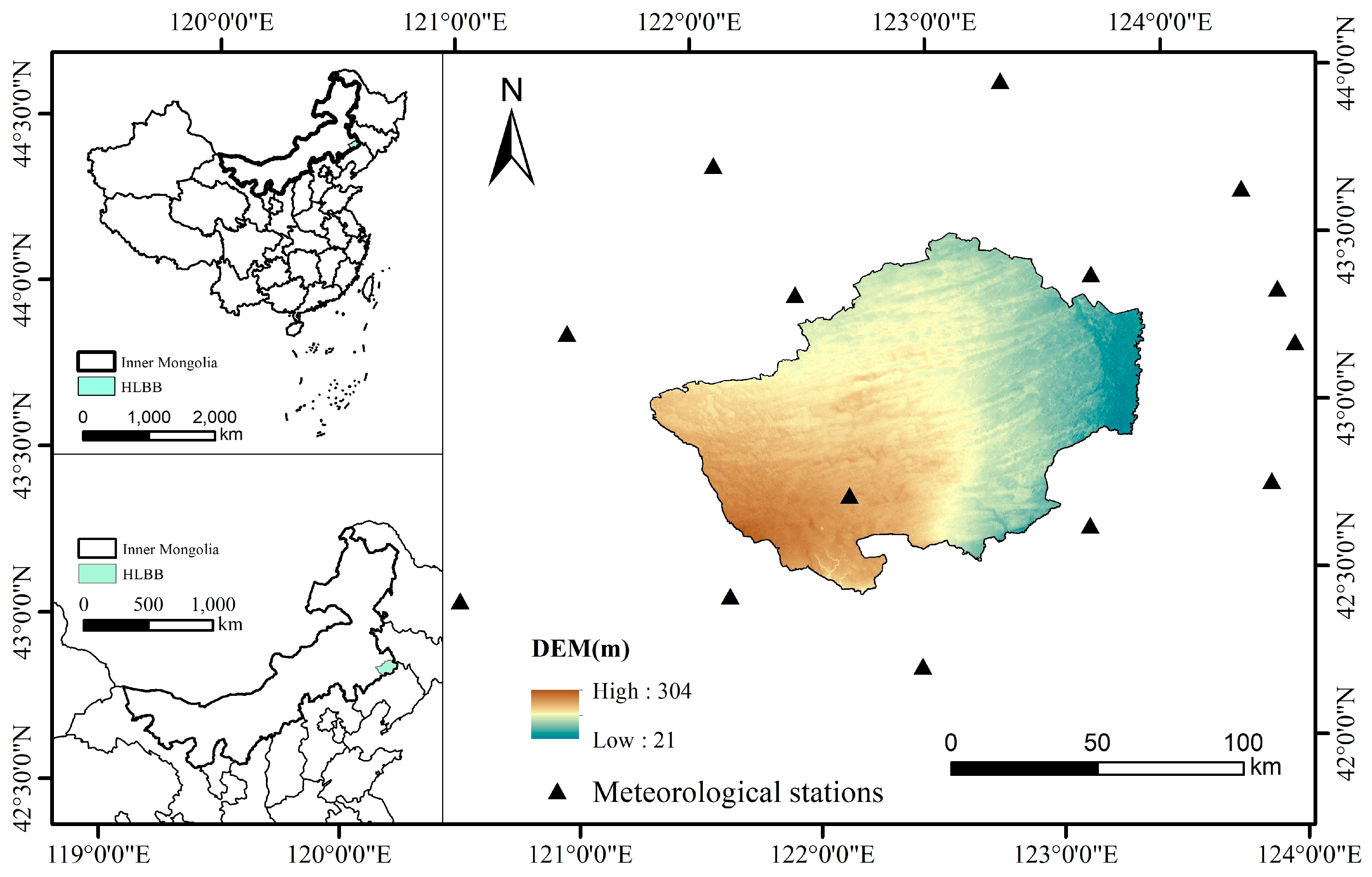
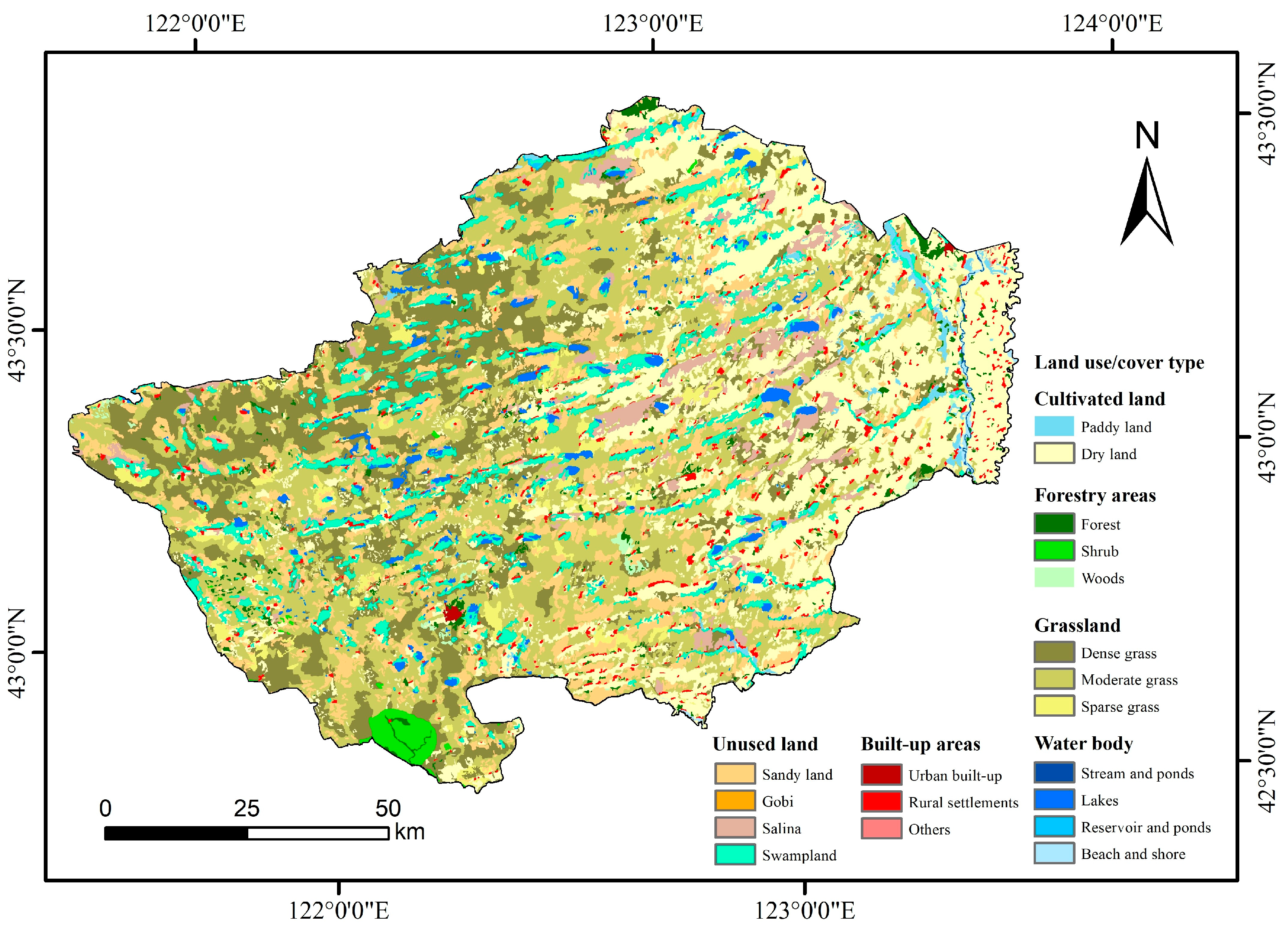
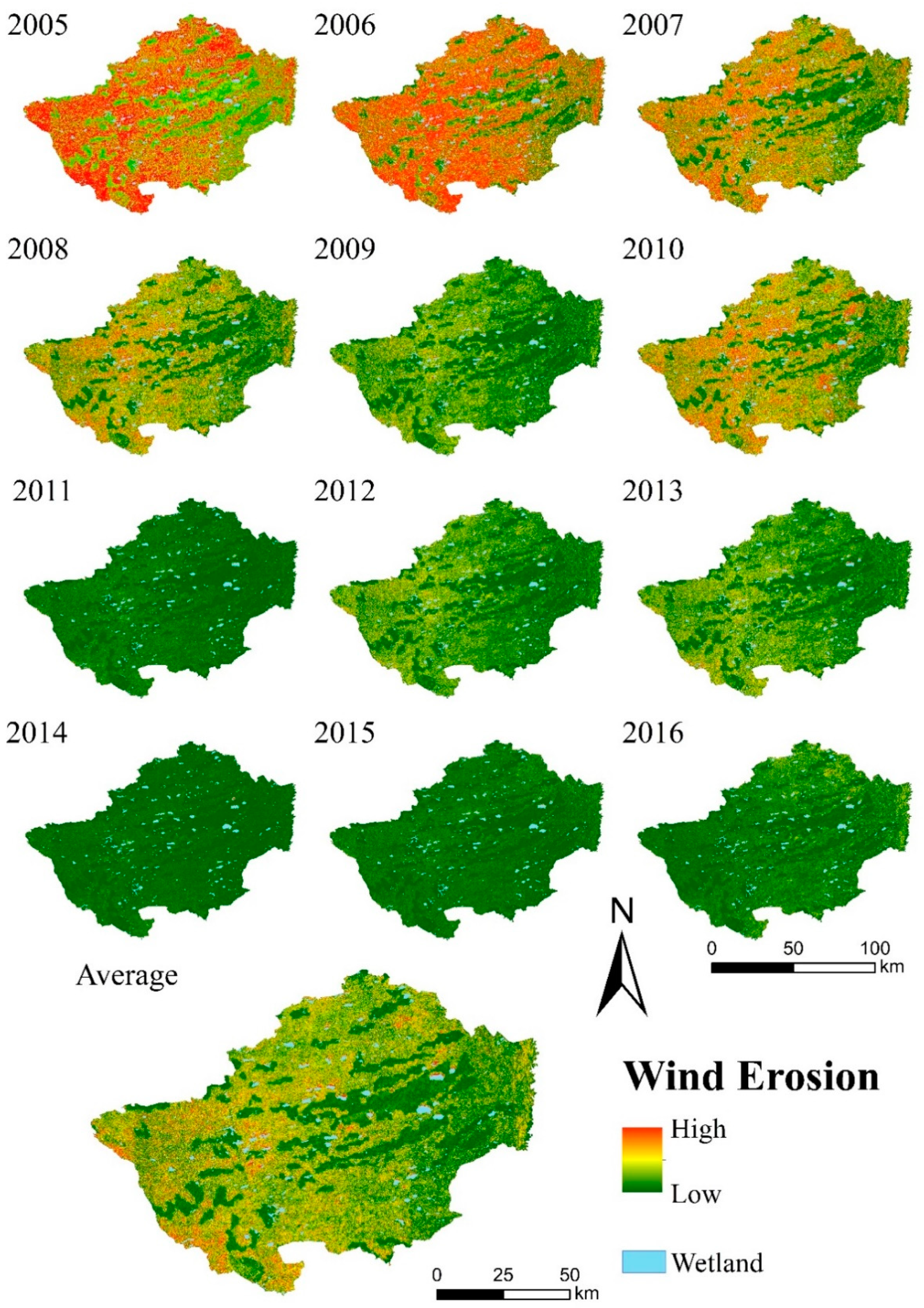

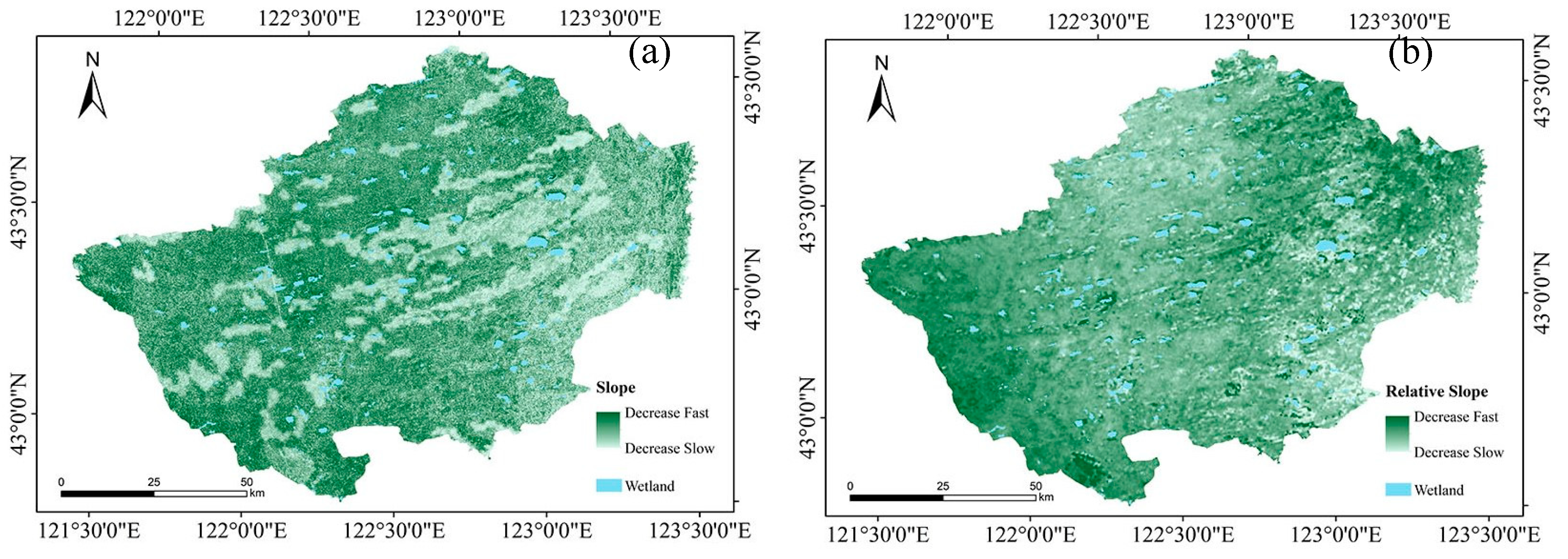
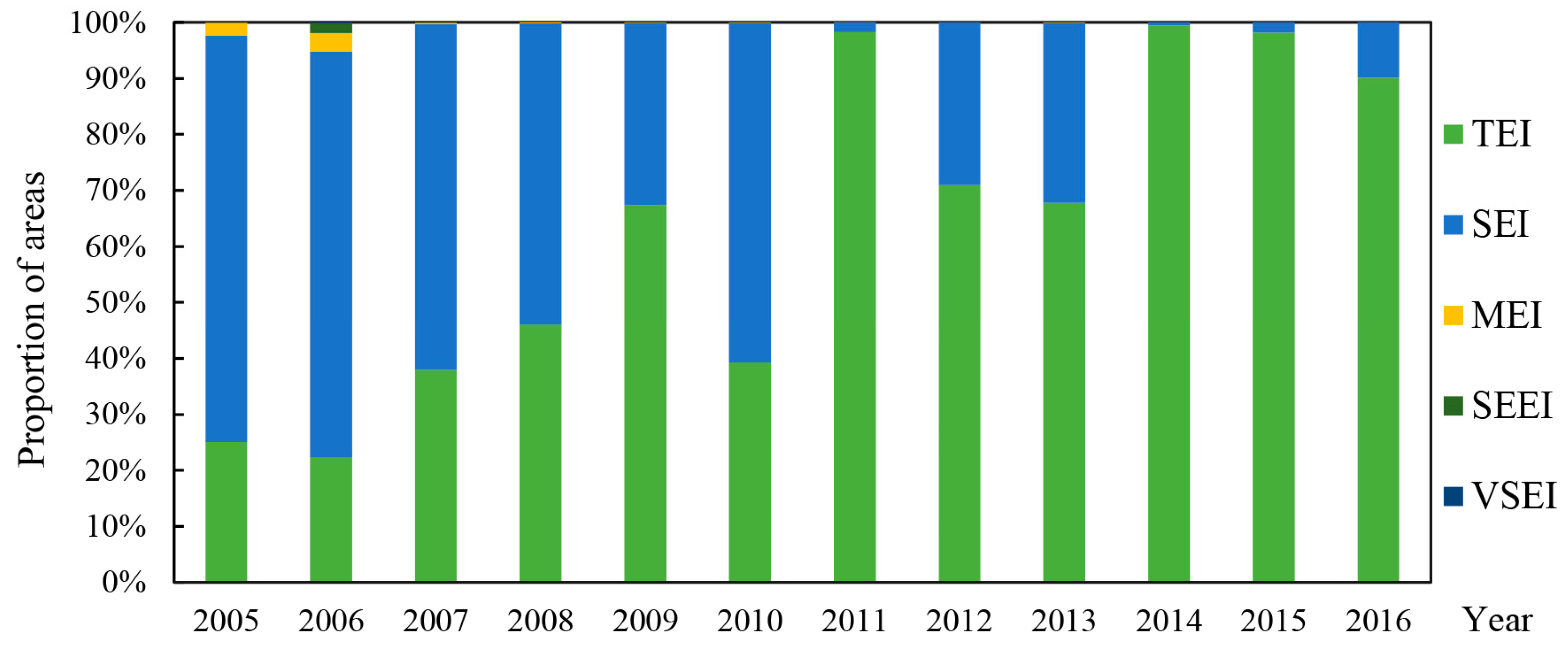
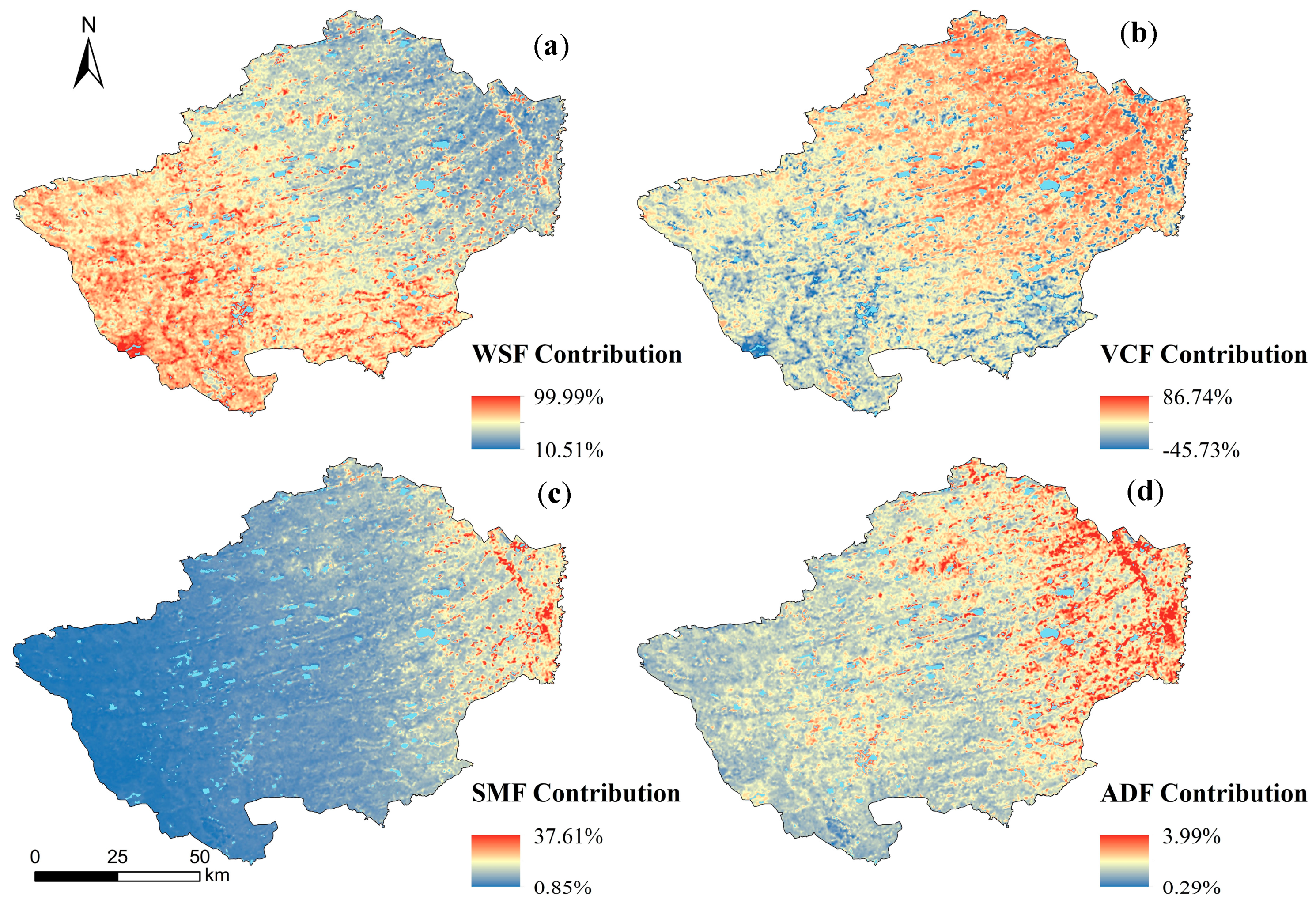
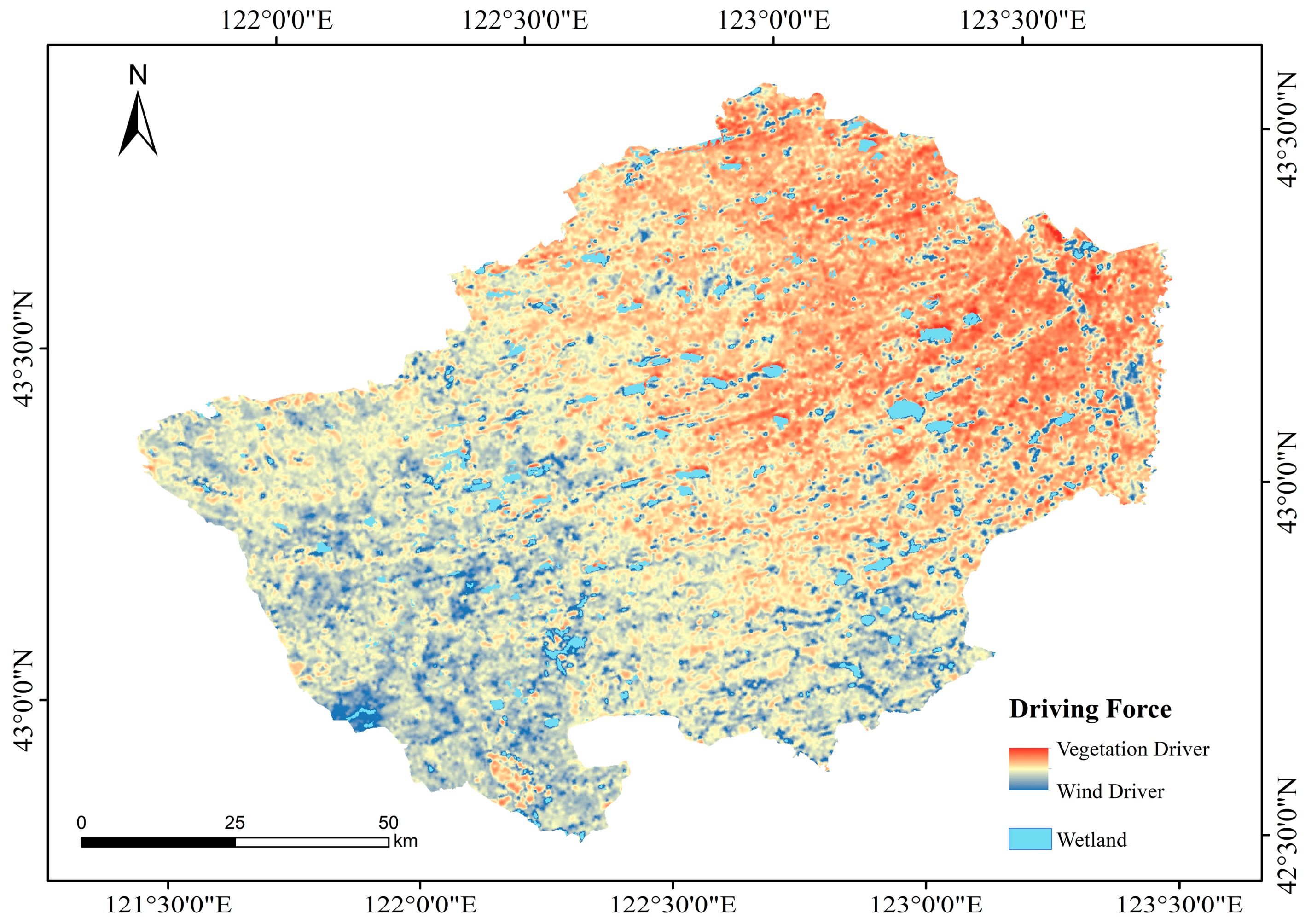
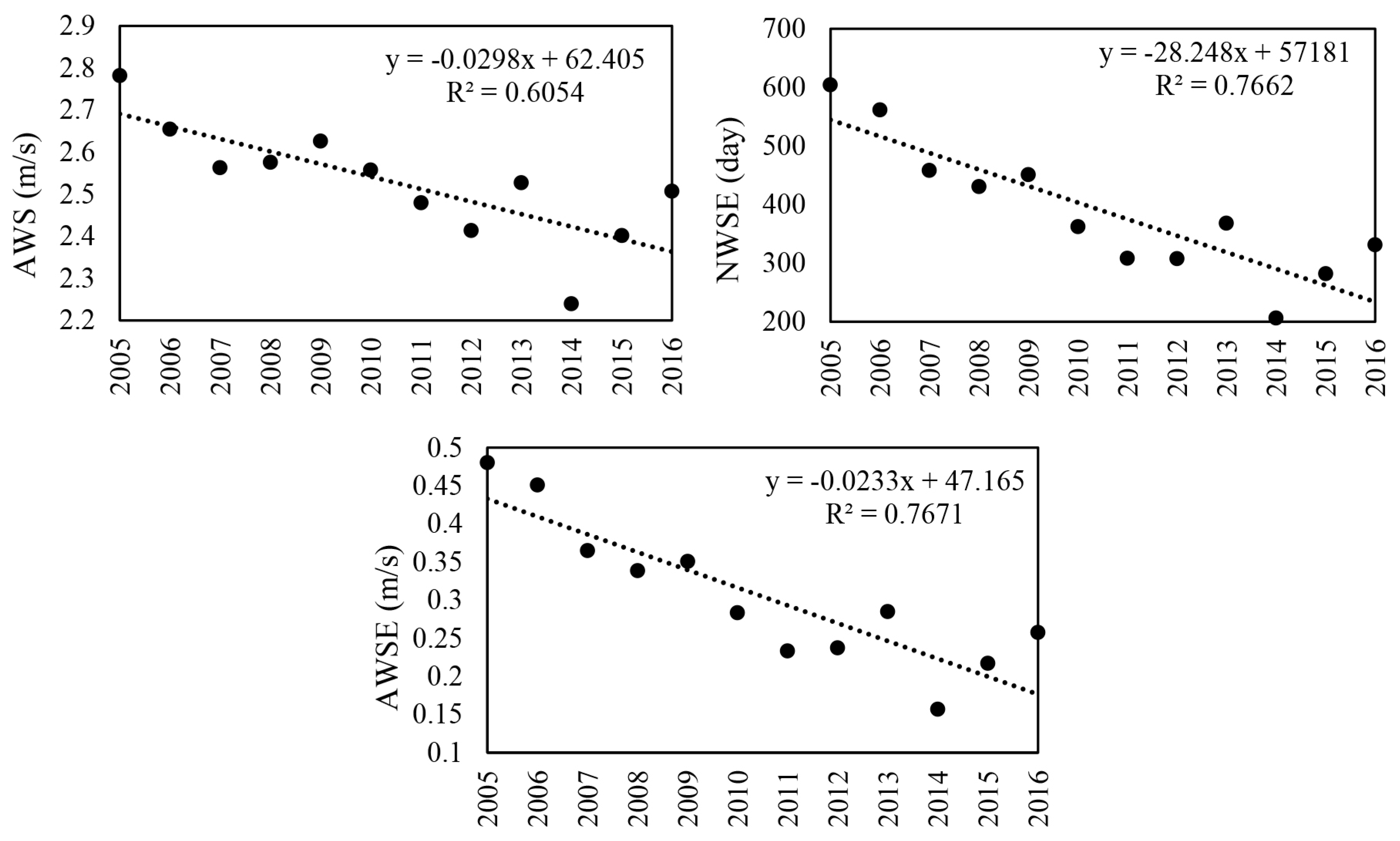
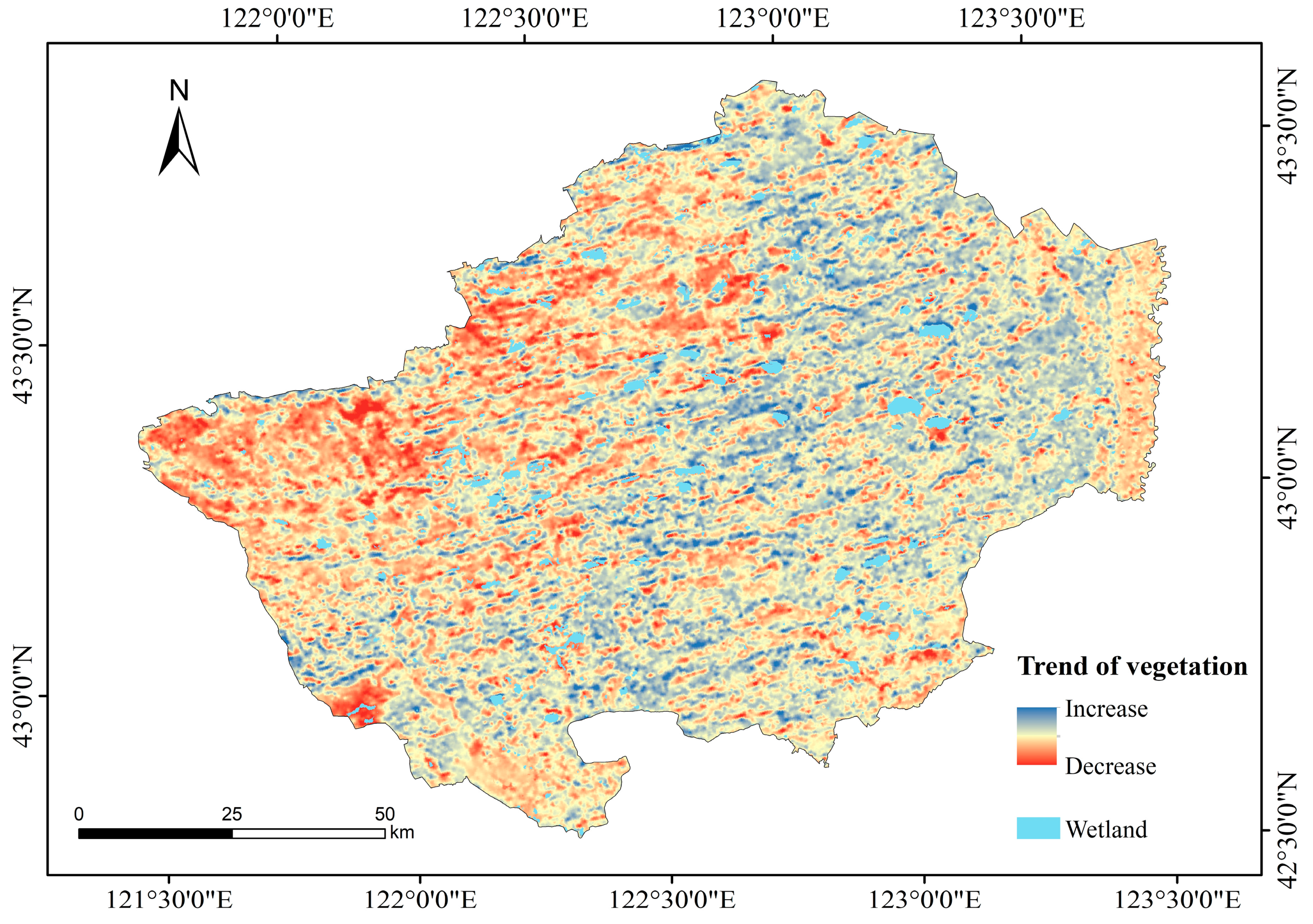
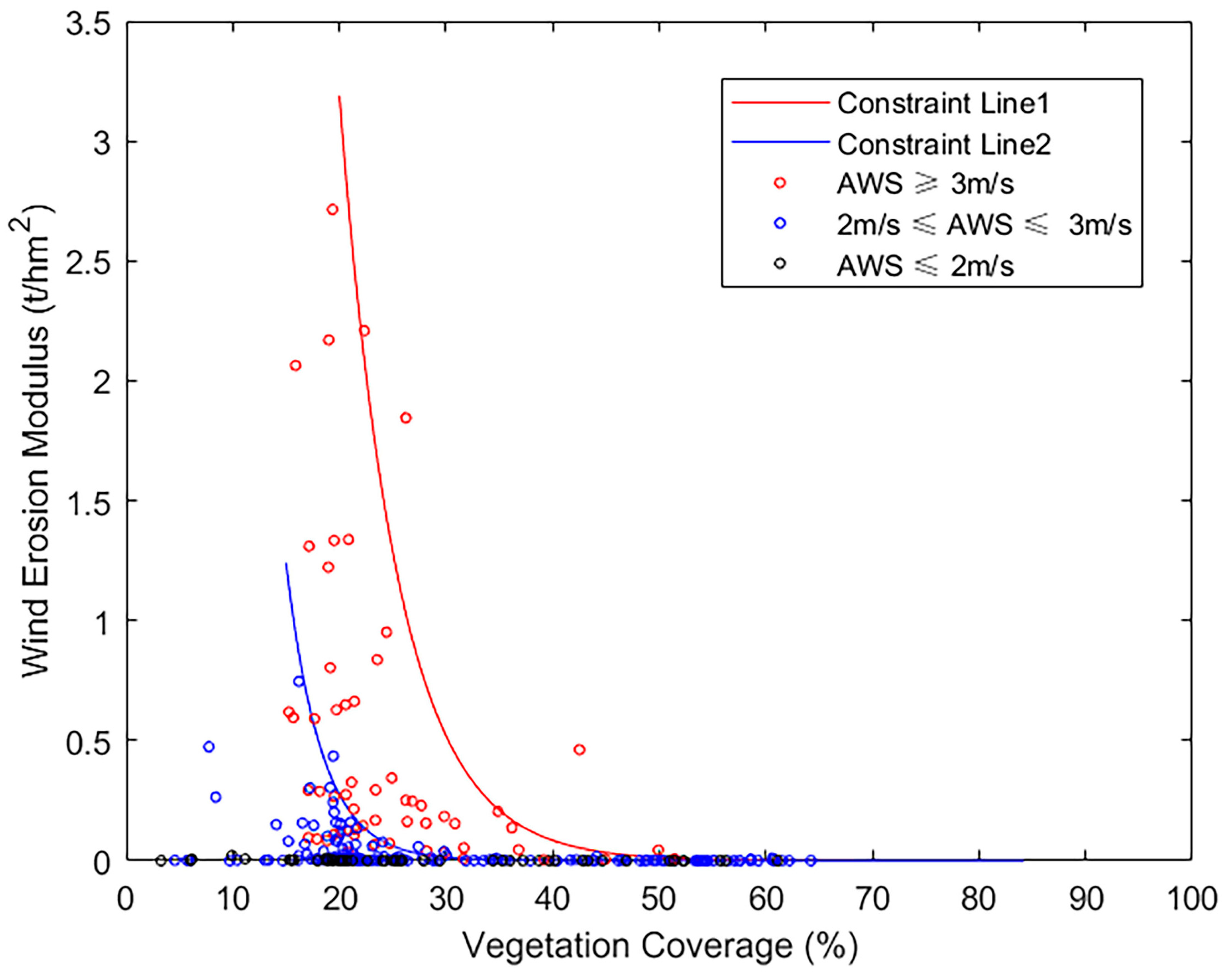

© 2019 by the authors. Licensee MDPI, Basel, Switzerland. This article is an open access article distributed under the terms and conditions of the Creative Commons Attribution (CC BY) license (http://creativecommons.org/licenses/by/4.0/).
Share and Cite
Zhang, H.; Gao, Y.; Sun, D.; Liu, L.; Cui, Y.; Zhu, W. Wind Erosion Changes in a Semi-Arid Sandy Area, Inner Mongolia, China. Sustainability 2019, 11, 188. https://doi.org/10.3390/su11010188
Zhang H, Gao Y, Sun D, Liu L, Cui Y, Zhu W. Wind Erosion Changes in a Semi-Arid Sandy Area, Inner Mongolia, China. Sustainability. 2019; 11(1):188. https://doi.org/10.3390/su11010188
Chicago/Turabian StyleZhang, Hanbing, Yang Gao, Danfeng Sun, Lulu Liu, Yanzhi Cui, and Wenjie Zhu. 2019. "Wind Erosion Changes in a Semi-Arid Sandy Area, Inner Mongolia, China" Sustainability 11, no. 1: 188. https://doi.org/10.3390/su11010188
APA StyleZhang, H., Gao, Y., Sun, D., Liu, L., Cui, Y., & Zhu, W. (2019). Wind Erosion Changes in a Semi-Arid Sandy Area, Inner Mongolia, China. Sustainability, 11(1), 188. https://doi.org/10.3390/su11010188




